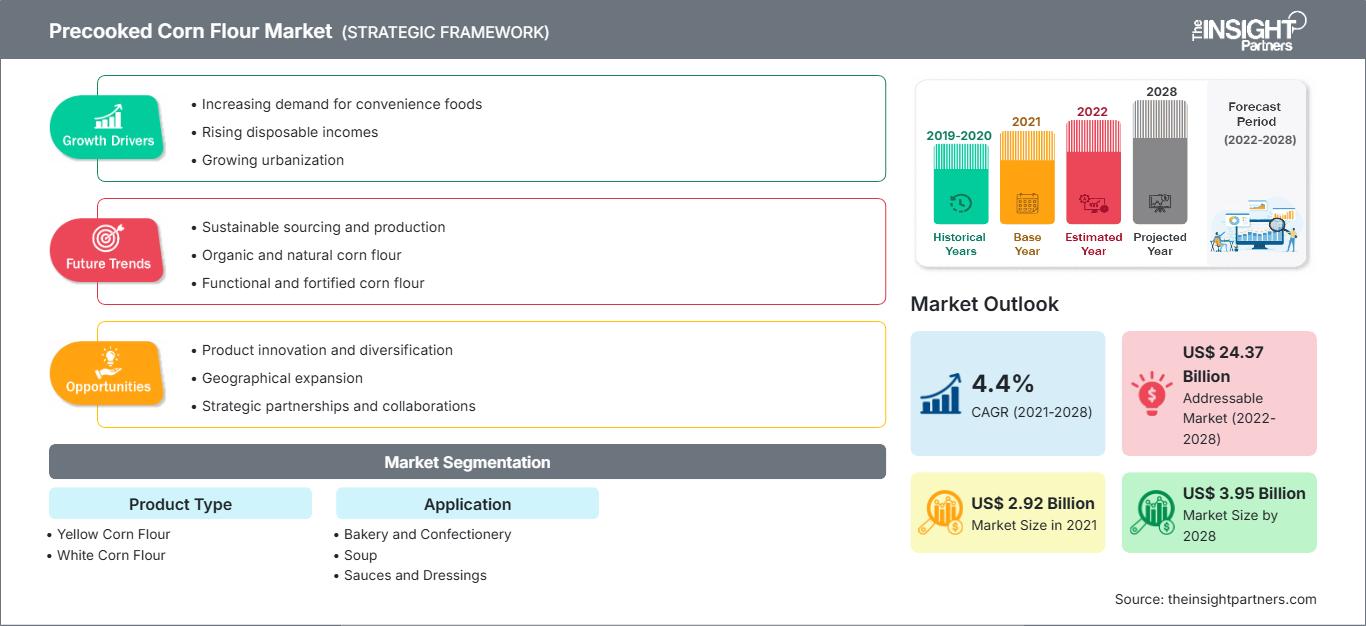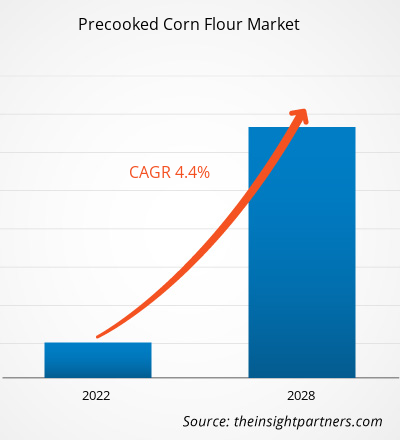El mercado de harina de maíz precocida se valoró en US$ 2.918,78 millones en 2021 y se proyecta que alcance los US$ 3.953,67 millones para 2028; se espera que crezca a una CAGR de 4,4% de 2021 a 2028.
La harina de maíz precocida no contiene gluten y es un ingrediente esencial para preparar tortillas, tamales y otros platillos mexicanos. La adopción de la cocina mexicana en todo el mundo está incrementando el consumo de harina de maíz precocida.
En 2020, Asia Pacífico dominó el mercado mundial de harina de maíz precocida y se espera que continúe su dominio durante el período de pronóstico. La creciente conciencia sobre los beneficios para la salud y el rico perfil nutricional que ofrecen los productos elaborados con harina de maíz precocida impulsa el crecimiento del mercado de harina de maíz precocida en toda la región. Además, el aumento de los ingresos disponibles y el creciente uso de la harina de maíz precocida han generado una creciente demanda de este producto. Asimismo, la creciente adopción y consumo de comida mexicana en países como Australia e India impulsa la demanda de harina de maíz precocida.
Personalice este informe según sus necesidades
Obtendrá personalización en cualquier informe, sin cargo, incluidas partes de este informe o análisis a nivel de país, paquete de datos de Excel, así como también grandes ofertas y descuentos para empresas emergentes y universidades.
Mercado de harina de maíz precocida: Perspectivas estratégicas

-
Obtenga las principales tendencias clave del mercado de este informe.Esta muestra GRATUITA incluirá análisis de datos, desde tendencias del mercado hasta estimaciones y pronósticos.
Perspectivas del mercado
Creciente demanda de productos alimenticios sin gluten
El consumo excesivo de gluten puede provocar graves problemas de salud, como sensibilidad, alergia al trigo y enfermedad celíaca. Según la Organización Mundial de Gastroenterología (OMG), la enfermedad celíaca afecta a personas de todas las edades. Además, según el Instituto de Medicina Funcional, la incidencia de la enfermedad celíaca aumenta un 7,5 % anual, con mayor incidencia entre mujeres y niños. El aumento de la demanda de productos alimenticios sin gluten se debe a la creciente preocupación por la salud de los consumidores. Estos factores impulsan la demanda de productos alimenticios sin gluten.
Información sobre tipos de productos
Según el tipo de producto, el mercado de harina de maíz precocida se clasifica en harina de maíz amarillo, harina de maíz blanco y otras. En 2020, el segmento de harina de maíz amarillo dominó el mercado. El aumento en su uso en panadería impulsó la demanda de harina de maíz precocida. Se utiliza para hornear galletas gracias a su textura suave y sus buenas propiedades aglutinantes. Además, los minerales y vitaminas presentes en la harina de maíz amarillo promueven su uso en una amplia gama de productos alimenticios nutritivos.
Los principales actores del mercado adoptan estrategias como fusiones y adquisiciones, así como lanzamientos de productos, para expandir su presencia geográfica y su base de consumidores. Algunos de los actores clave que operan en el mercado de harina de maíz precocida son Archer Daniels Midland Company, Cargill Incorporated, Limagrain (Limagrain Ingredients), Agricor, Buhler, Favero Antonio SRL, Molino Peila SpA, SEMO Milling LLC, Bunge Limited y Gruma SAB de CV.
Informe destacado
- Tendencias progresivas en el mercado de harina de maíz precocida para ayudar a los actores a desarrollar estrategias efectivas a largo plazo.
- Estrategias de crecimiento adoptadas por las empresas para asegurar el crecimiento en los mercados desarrollados y en desarrollo
- Análisis cuantitativo del mercado global de harina de maíz precocida de 2019 a 2028
- Estimación de la demanda de harina de maíz precocida en diversas industrias
- Análisis de Porter para ilustrar la eficacia de los compradores y proveedores que operan en la industria para predecir el crecimiento del mercado
- Desarrollos recientes para comprender el escenario competitivo del mercado y la demanda de harina de maíz precocida
- Tendencias y perspectivas del mercado junto con los factores que impulsan y restringen el crecimiento del mercado de harina de maíz precocida
- Comprender las estrategias que sustentan el interés comercial con respecto al crecimiento del mercado mundial de harina de maíz precocida, ayudando en el proceso de toma de decisiones.
- Tamaño del mercado de harina de maíz precocida en varios nodos del mercado
- Descripción general detallada y segmentación del mercado global de harina de maíz precocida, así como su dinámica industrial.
- Tamaño del mercado de harina de maíz precocida en varias regiones con prometedoras oportunidades de crecimiento
El "Análisis del Mercado Global de Harina de Maíz Precocida hasta 2028" es un estudio especializado y profundo de la industria de bienes de consumo, con especial énfasis en el análisis de las tendencias del mercado global de harina de maíz precocida. El informe busca ofrecer una visión general del mercado con una segmentación detallada. El mercado de harina de maíz precocida se segmenta según el tipo de producto, la aplicación y la geografía. Según el tipo de producto, el mercado se clasifica en harina de maíz amarillo, harina de maíz blanco y otros. Según la aplicación, el mercado de harina de maíz precocida se segmenta en panadería y repostería, sopas, salsas y aderezos, comidas y alimentos listos para comer, snacks extruidos y otros. Según la geografía, el mercado de harina de maíz precocida se segmenta en cinco regiones principales: Norteamérica, Europa, Asia-Pacífico, Oriente Medio y África, y Sudamérica y Centroamérica.
Perspectivas regionales del mercado de harina de maíz precocida
Los analistas de The Insight Partners han explicado detalladamente las tendencias regionales y los factores que influyen en el mercado de harina de maíz precocida durante el período de pronóstico. Esta sección también analiza los segmentos y la geografía del mercado de harina de maíz precocida en América del Norte, Europa, Asia Pacífico, Oriente Medio y África, y América del Sur y Central.
Alcance del informe de mercado de harina de maíz precocida
| Atributo del informe | Detalles |
|---|---|
| Tamaño del mercado en 2021 | US$ 2.92 mil millones |
| Tamaño del mercado en 2028 | 3.950 millones de dólares estadounidenses |
| CAGR global (2021-2028) | 4,4% |
| Datos históricos | 2019-2020 |
| Período de pronóstico | 2022-2028 |
| Segmentos cubiertos |
Por tipo de producto
|
| Regiones y países cubiertos |
América del norte
|
| Líderes del mercado y perfiles de empresas clave |
|
Densidad de actores del mercado de harina de maíz precocida: comprensión de su impacto en la dinámica empresarial
El mercado de la harina de maíz precocida está creciendo rápidamente, impulsado por la creciente demanda del consumidor final debido a factores como la evolución de las preferencias de los consumidores, los avances tecnológicos y un mayor conocimiento de los beneficios del producto. A medida que aumenta la demanda, las empresas amplían su oferta, innovan para satisfacer las necesidades de los consumidores y aprovechan las tendencias emergentes, lo que impulsa aún más el crecimiento del mercado.

- Obtenga una descripción general de los principales actores clave del mercado de harina de maíz precocida
Perfiles de empresas
- Compañía Archer Daniels Midland
- Cargill Incorporated
- Limagrain (Ingredientes de Limagrain)
- Agricor
- Bühler
- Favero Antoniop SRL
- Molino Peila SpA
- SEMO Milling LLC
- Bunge Limited
- Gruma SAB de CV
- Análisis histórico (2 años), año base, pronóstico (7 años) con CAGR
- Análisis PEST y FODA
- Tamaño del mercado, valor/volumen: global, regional y nacional
- Industria y panorama competitivo
- Conjunto de datos de Excel
Informes recientes
Informes relacionados
Testimonios
Razón para comprar
- Toma de decisiones informada
- Comprensión de la dinámica del mercado
- Análisis competitivo
- Información sobre clientes
- Pronósticos del mercado
- Mitigación de riesgos
- Planificación estratégica
- Justificación de la inversión
- Identificación de mercados emergentes
- Mejora de las estrategias de marketing
- Impulso de la eficiencia operativa
- Alineación con las tendencias regulatorias






















 Obtenga una muestra gratuita para - Mercado de harina de maíz precocida
Obtenga una muestra gratuita para - Mercado de harina de maíz precocida